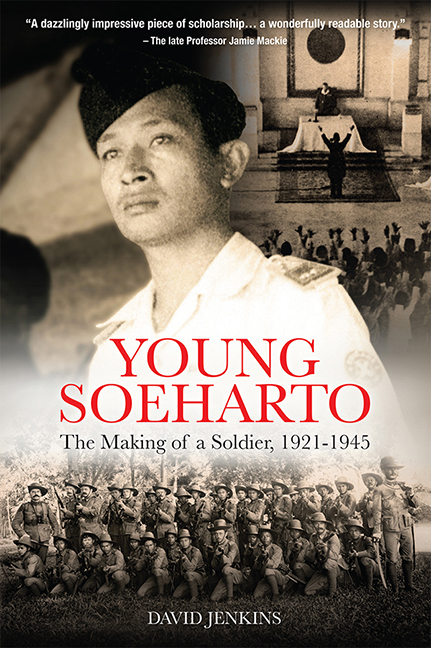Book contents
- Frontmatter
- Contents
- Foreword
- A Note on Spelling and Names
- A Note on Military Organization
- Maps
- List of Charts
- Preface
- Soeharto Family Tree
- 1 “The Sultan came to me and asked about that Family tree”
- 2 “The Cork on which the Netherlands Floats”
- 3 “They Regard Holland as a very Weak Power”
- 4 “An Invisible Motivating Force”
- 5 “What kind of Islam is this?”
- 6 “Soeharto is a Closed Book”
- 7 “I was Suited to the Disciplined life of the Military”
- 8 A Reassuringly Familiar World
- 9 A Policeman for the Japanese
- 10 An Armed Force Conjured out of Nothing
- 11 “The whole Island was Ablaze with Enthusiasm”
- 12 “Don’t make them too Strong!”
- 13 “Soeharto was a Cautious Man”
- 14 “Why did they Choose Soeharto?”
- Glossary and Abbreviations
- Notes
- Acknowledgements
- Bibliography
- Index
- About the Author
- Frontmatter
- Contents
- Foreword
- A Note on Spelling and Names
- A Note on Military Organization
- Maps
- List of Charts
- Preface
- Soeharto Family Tree
- 1 “The Sultan came to me and asked about that Family tree”
- 2 “The Cork on which the Netherlands Floats”
- 3 “They Regard Holland as a very Weak Power”
- 4 “An Invisible Motivating Force”
- 5 “What kind of Islam is this?”
- 6 “Soeharto is a Closed Book”
- 7 “I was Suited to the Disciplined life of the Military”
- 8 A Reassuringly Familiar World
- 9 A Policeman for the Japanese
- 10 An Armed Force Conjured out of Nothing
- 11 “The whole Island was Ablaze with Enthusiasm”
- 12 “Don’t make them too Strong!”
- 13 “Soeharto was a Cautious Man”
- 14 “Why did they Choose Soeharto?”
- Glossary and Abbreviations
- Notes
- Acknowledgements
- Bibliography
- Index
- About the Author
Summary
At around 7:15 a.m. on Friday, 1 October 1965, Lieutenant Colonel Untung, a battalion commander in President Sukarno's Tjakrabirawa palace guard, issued a startling proclamation over Radio Republik Indonesia. A hitherto unknown “September 30th Movement”, he declared, had saved the head of state from a CIA-backed “Council of Generals” which was plotting to overthrow the government. What Untung did not disclose was that three or four hours earlier Tjakrabirawa troops had murdered the Army Commander, Lieutenant General Achmad Yani, and two other prominent generals in their homes and had kidnapped and murdered, or were about to murder, three more generals. The Defence Minister, General A.H. Nasution, had narrowly escaped assassination; his five-year-old daughter had been mortally wounded, a young lieutenant seized and murdered. By late that afternoon, Major General Soeharto, the commander of the Army Strategic Reserve (Kostrad), had marshalled a counter force, won over a battalion of September 30th troops guarding key locations in central Jakarta and put a second battalion to flight. A botched and brutal strike against army leaders known for their hostility to the large Indonesian Communist Party (Partai Komunis Indonesia, PKI) had failed. And although there remained a dangerous standoff in Central Java, where many units had come out in favour of the September 30th Movement, the power balance in Jakarta had changed irrevocably.
On the following Monday, a day of strong emotion and high drama in Indonesia, the army recovered the bodies of the six generals and the lieutenant from a disused well known as the Crocodile Hole. The corpses were bloated and blackened, in most cases barely recognizable. Eleven days later, Soeharto gave a report on recent developments to leaders of the National Front, a left-leaning body Sukarno had established to mobilize political parties and other groups behind government policies. “We have found the bodies of the generals,” he said at one point, in what appears to have been an informal exchange with front members. “But I am also a general and many of you don't know me.” He then gestured towards K.P.H. Haryasudirja Sasraningrat, a thirty-nine-year-old Javanese aristocrat who was Minister for Water Resources in Sukarno's cabinet. “If you have any questions about me,” he continued, “well, Mr Haryasudirja can answer you.”
- Type
- Chapter
- Information
- Young SoehartoThe Making of a Soldier, 1921–1945, pp. xxiii - xliiiPublisher: ISEAS–Yusof Ishak InstitutePrint publication year: 2021

